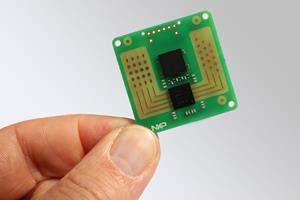NXP Expands Its Market-Leading Radar Portfolio With Highly Integrated CMOS Single-Chip for Postage Stamp Sized Radar Sensors
CES 2016 – NXP Semiconductors N.V. (NASDAQ:NXPI), global market leader in secure connected car technologies, today announced the next step in innovation for its market-leading automotive radar portfolio: the world’s smallest single-chip 77GHz radar transceiver (7.5×7.5 mm) with very high resolution performance. Radar is a core technology in existing and future Advanced Driver Assistance Systems (ADAS), as it provides precise data about the surrounding driving environment, ultimately making life safer for drivers and commuters on the road. Working prototypes of the RFCMOS IC are in the hands of NXP’s lead customers; they are also currently being field tested by Google engineers working on the self-driving cars project.
The NXP chip enables a new generation of radar sensor assemblies, roughly the size of a postage stamp, that can be integrated “invisibly” practically anywhere in the car – a great advantage for vehicle designers as the number of sensors steadily increases on the road towards automated driving. Its power consumption is 40 percent lower than conventional radar ICs. Key safety applications include emergency braking, adaptive cruise control, blind-spot monitoring, cross-traffic alert and automated-parking.
“Building the world’s smallest, fully integrated 77GHz chip will pave the way for self-driving cars and drive increased ADAS adoption in the volume market,” said Torsten Lehmann, senior vice president infotainment and driver assistance at NXP. “In self-driving cars, a ‘cocoon’ of radar sensors is required to provide a robust high-resolution, 360 degree view of the environment. This is a real challenge using traditional, bulky radar hardware. Manufacturers are also eager to replace existing ultra-sonic based park distance control systems with “invisible” radar sensors and avoid unattractive holes in the bumper while improving performance and features.”
Radar-based ADAS will have a steep penetration over the next years with IHS Research estimating the market to grow to more than 50 million radar sensors in 2021*, a 23 percent year-on-year increase from today. Next to technology advances in size, power consumption and system affordability, NCAP (New Car Assessment Programs) is another growth driver for ADAS systems. NCAPs exist around the globe and offer rewards programs for proven ADAS systems, such as autonomous emergency braking and pedestrian protection systems.
With the completion of its merger with Freescale Semiconductor on December 7, 2015, NXP is now a leader in providing ADAS solutions to the automotive market. The new RFCMOS IC is an excellent extension of the company’s existing strong radar IC portfolio. The combined product offering includes a range of market-leading 77 GHz transceivers for long, mid, and short-range radar applications, scalable from entry levels to premium vehicles, as well as high-performance radar signal processors and MCUs. To date, more than one million radar ICs have been shipped. The combined strengths of both companies pave the way for up-integration in the future: a single-chip automotive radar SoC including front-end and baseband processors on a monolithic die for next-generation radar ICs.
Source: IHS, Advanced Driver Assistance Applications Semiconductor Market Tracker – H1 2015
Availability
Working prototypes are available to key customers.



















